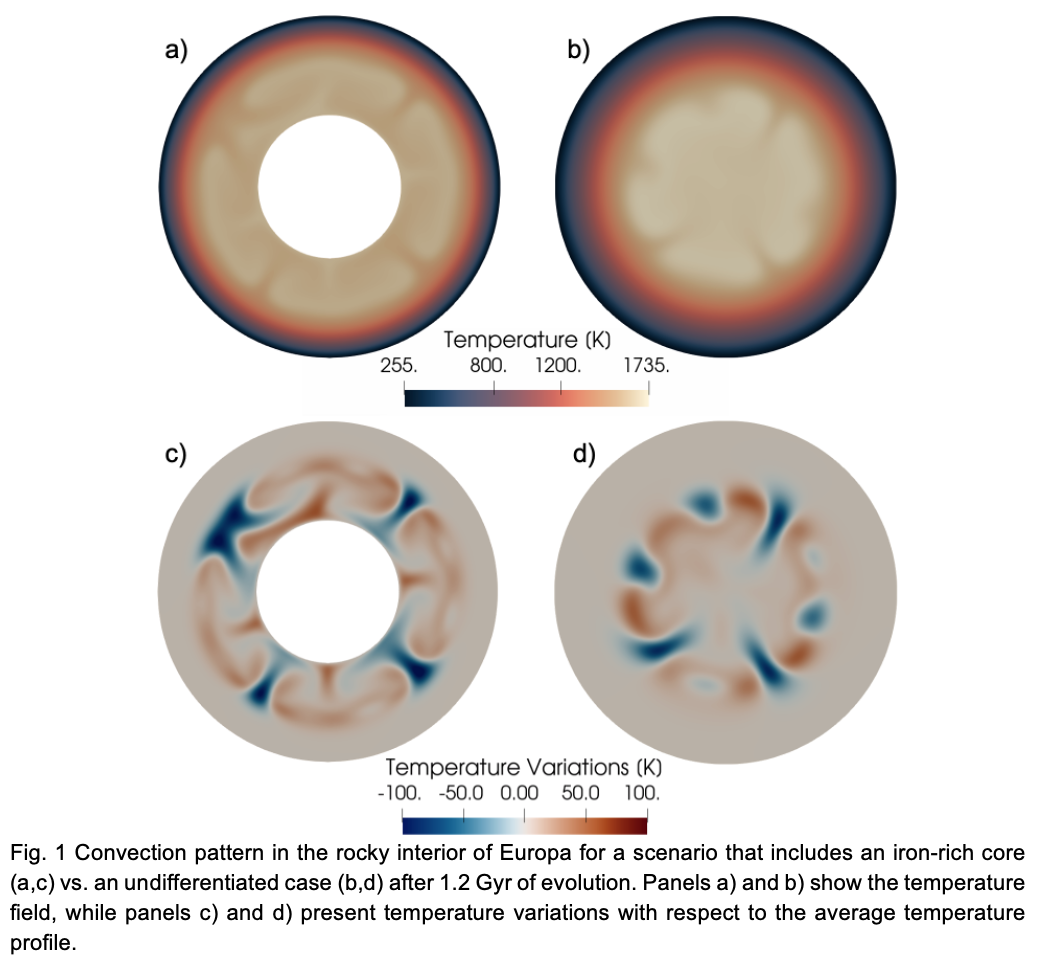Solid-state convection in Europa’s rocky core
- 1Institute of Planetary Research German Aerospace Center (DLR)
- 2Institut für Planetologie, Universität Münster
The subsurface ocean beneath Europa's icy crust is thought to be in direct contact with its rocky interior [1]. Interactions between the saline ocean and the silicate interior may have led to analogous hydrothermal processes as those observed at Earth's seafloor [2], rendering Europa a prime target for searching for habitable environments beyond our planet [3]. However, understanding the formation and evolution of such environments requires a thorough analysis of the heat transfer and magmatic processes occurring within the rocky interior. These processes have a first-order impact on the heat flux at the ocean floor and on the composition of the ocean due to the transport of chemical species through fluid-rock interactions and magmatic eruptions.
In a previous study, Behounková et al. [4] investigated the effects of tidal heating on thermal convection and magmatism in Europa's rocky core. Assuming instantaneous melt extraction, the study found that partial melt production in the interior occurs over most of the thermal history. Melting rates are enhanced during episodes of high eccentricity, and melting becomes more focused at high latitudes, where tidal dissipation is strongest.
A more recent study by Trinh et al. [5] suggests a slow evolution of Europa's interior governed by low initial temperatures that prevent rapid differentiation of the interior into a silicate mantle and an iron-rich core. In fact, starting with an ice-rock undifferentiated body, core formation occurs late during the evolution, possibly billions of years after Europa's formation. While many previous studies assumed the presence of a metallic core inside Europa [6, 7, 8], this recent contribution demonstrates that this interior structure is not necessarily guaranteed and that an undifferentiated deep interior may also be possible.
Drawing on these findings, our study specifically addresses the evolution of Europa's deep interior, focusing on solid-state convection in the rocky part. To this end, we employ geodynamic models using the fluid flow solver GAIA [9] in 2D and 3D geometries [10, 11]. We test scenarios with and without a differentiated rocky interior; while the former are simulated using a 3D spherical shell/2D annulus and include both internal heating by radioactive heat sources and heating from the core, the latter are modeled using a full 3D sphere/2D circle and only consider internal heated convection. Similar to [4], we consider melting and magmatic heat transport but use a more sophisticated melting model that distinguishes between different magmatic styles (i.e., intrusive and extrusive magmatism). We vary the ratio of intrusive to extrusive melt and the depth of melt intrusions to investigate the effect of magmatic heat transport on the evolution of the rocky interior. In our models, we incorporate the effects of tidal heating using an approach similar to [4].

In Figure 1, we present preliminary results of convection within the interior of Europa's rocky core in a 2D geometry assuming both differentiated and undifferentiated scenarios. The snapshots show the temperature distribution after 1.2 Gyr of evolution. The distinct convection patterns between differentiated and undifferentiated interiors have important implications for heat flux variations and the distribution of partial melt zones within Europa's interior. Subsequent investigations will systematically analyze the heat fluxes at the ocean-silicate interface, interior temperatures, and degree of magmatic differentiation for cases with and without an iron-rich core. Additionally, based on the temperature variations obtained in our models, we will calculate the associated density variations and use these to compute the geoid and dynamic topography signature of the differentiated and undifferentiated scenarios at present day.
References:
[1] Moore, W. B., Hussmann, H., Pappalardo, R. T., McKinnon, W. B., & Khurana, K. (2009). Thermal evolution of Europa’s silicate interior. Europa, 369-380.
[2] Vance, S. D., Hand, K. P., & Pappalardo, R. T. (2016). Geophysical controls of chemical disequilibria in Europa. Geophysical Research Letters, 43(10), 4871-4879.
[3] Hand, K. P., Chyba, C. F., Priscu, J. C., Carlson, R. W., & Nealson, K. H. (2009). Astrobiology and the potential for life on Europa. Europa, 589-629.
[4] Běhounková, M., Tobie, G., Choblet, G., Kervazo, M., Melwani Daswani, M., Dumoulin, C., & Vance, S. D. (2021). Tidally induced magmatic pulses on the oceanic floor of Jupiter's moon Europa. Geophysical Research Letters, 48(3), e2020GL090077.
[5] Trinh, K. T., Bierson, C. J., & O’Rourke, J. G. (2023). Slow evolution of Europa’s interior: Metamorphic ocean origin, delayed metallic core formation, and limited seafloor volcanism. Science Advances, 9(24), eadf3955.
[6] Schubert, G., Sohl, F., & Hussmann, H. (2009). Interior of Europa. Europa, 35, 3-367.
[7] Travis, B. J., Palguta, J., & Schubert, G. (2012). A whole-moon thermal history model of Europa: Impact of hydrothermal circulation and salt transport. Icarus, 218(2), 1006-1019.
[8] Dasgupta, R., Buono, A., Whelan, G., & Walker, D. (2009). High-pressure melting relations in Fe–C–S systems: Implications for formation, evolution, and structure of metallic cores in planetary bodies. Geochimica et Cosmochimica Acta, 73(21), 6678-6691.
[9] Hüttig, C., Tosi, N., & Moore, W. B. (2013). An improved formulation of the incompressible Navier–Stokes equations with variable viscosity. Physics of the Earth and Planetary Interiors, 220, 11-18.
[10] Hüttig, C., & Stemmer, K. (2008). The spiral grid: A new approach to discretize the sphere and its application to mantle convection. Geochemistry, Geophysics, Geosystems, 9(2).
[11] Fleury, A., Plesa, A. C., Hüttig, C., & Breuer, D. (2024). Assessing the accuracy of 2‐D planetary evolution models against the 3‐D sphere. Geochemistry, Geophysics, Geosystems, 25(2), e2023GC011114.
How to cite: Holm, A. L., Plesa, A.-C., Rückriemen-Bez, T., Maia, J., Hüttig, C., and Gundlach, B.: Solid-state convection in Europa’s rocky core, Europlanet Science Congress 2024, Berlin, Germany, 8–13 Sep 2024, EPSC2024-699, https://doi.org/10.5194/epsc2024-699, 2024.